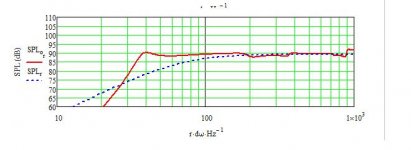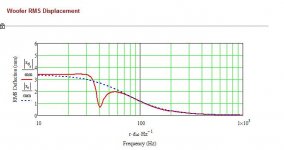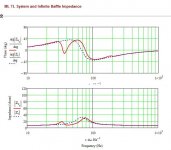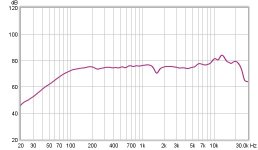Wiggle,
Here are the mathcad results.
I haven't had time to optimize the design, but IMO this design is tuned too low.
The saddle-shaped hump before roll-off usually results in a bass response that is perceived as untidy.
Furthermore, I have attached the cone displacement graph should you need it.
The model contains 0.3 lbs/Cft of damping material in the top third part of the enclosure.
Simulated at 2 watt input.
Also note that MJK's worksheets do not take into consideration the added resistive component that comes with a high aspect ratio port.
Hope it helps.
Regards
Nick
Here are the mathcad results.
I haven't had time to optimize the design, but IMO this design is tuned too low.
The saddle-shaped hump before roll-off usually results in a bass response that is perceived as untidy.
Furthermore, I have attached the cone displacement graph should you need it.
The model contains 0.3 lbs/Cft of damping material in the top third part of the enclosure.
Simulated at 2 watt input.
Also note that MJK's worksheets do not take into consideration the added resistive component that comes with a high aspect ratio port.
Hope it helps.
Regards
Nick
Attachments
Thank you hajj and Valeric. Perhaps I should be looking at modifying the tuning. I will also find these tools and try to figure my way around them.
Also note that MJK's worksheets do not take into consideration the added resistive component that comes with a high aspect ratio port.
Few do and the difference is major, so as is the cab will be tuned enough lower to make an audible difference/reduce power handling. The main cause though is that with a shelf vent, three of the four vent walls are very long, so the shelf must do all the compensating to average out its acoustic path-length.
This calculator will get you a lot closer, i.e. much shorter vent, though it won't factor in any 1/4 WL TL loading nor any very high aspect ratio acoustic resistance, so still will be a bit too long and why you may want to experiment with different length shelves and even no shelf at all, the most often choice selected in the MLTLs I've done or spec'd for others: Car Audio - PORT Size Calculations and Formulas for WOOFER and Subwoofer BOXES
Note that 'bjorno' posted a very comprehensive vent design tutorial here some years ago, but lost my link, so recommend finding it to help with the various types of vents and their 'end corrections' that combined with its physical length makes up its effective acoustic path-length.
GM
Thank you hajj and Valeric. Perhaps I should be looking at modifying the tuning. I will also find these tools and try to figure my way around them.
Wiggle8,
Probably, but it's not a big change in tuning. But I would suggest tuning in to 50-55 Hz range.
Regarding the tools, I only have direct experience with LATL, but my impression is MJK's worksheets model stuffing better. That said, LATL is easier to load (doesn't require MathCad), and, I suspect, a easier to use. I highly recommend downloading LATL and playing around with it. If you find that it is useful and you enjoy doing it, you may want to put in the extra effort to get and learn the MJK worksheets too.
Eric
Thanks. As another option I am thinking about, what do you guys think of the pluvia 7 in an open baffle configuration? . Mounted atop a sealed SDX10 and crossed over around 150 or 200 Hz. Would a 6" wide baffle be a reasonable choice? . I haven't been able to find much information on how to determine the ideal baffle size.
Member
Joined 2009
Paid Member
Any further updates on sound impressions of the P7, especially
a) does the bass compare at all with EL-70, which Scott described as 'fairly startling LF output for a 4in driver"
b) how is the treble - any hotness or shout up there in the presence region after break-in ? (the published curves show something happening at 1.5kHz with a wiggle in the impedance plot and a dip/peak in the FR plot just after it)
a) does the bass compare at all with EL-70, which Scott described as 'fairly startling LF output for a 4in driver"
b) how is the treble - any hotness or shout up there in the presence region after break-in ? (the published curves show something happening at 1.5kHz with a wiggle in the impedance plot and a dip/peak in the FR plot just after it)
Last edited:
It was (EL70). P7 & CHR70.3 aren't far off. The EL was somewhat abnormal in that regard, largely due to the very soft suspension (for a long-stroke widebander).
Nothing AFAIK in the presence region to cause alarm. Per usual with the MA units you get a largely suspension-related interaction that can be seen on the impedance & FR plots: minor spike in the former (also seen as a spike in 2nd order HD), with matching notch in the latter. It's fairly high Q, so broadly speaking benign. If it were associated with higher order HD spikes, that would be another matter. You can find similar traits in many units -a number of Scan Speak and Seas midbass units have the same, SB's Satori midbass etc.
Nothing AFAIK in the presence region to cause alarm. Per usual with the MA units you get a largely suspension-related interaction that can be seen on the impedance & FR plots: minor spike in the former (also seen as a spike in 2nd order HD), with matching notch in the latter. It's fairly high Q, so broadly speaking benign. If it were associated with higher order HD spikes, that would be another matter. You can find similar traits in many units -a number of Scan Speak and Seas midbass units have the same, SB's Satori midbass etc.
But, at least for me, P7 fits into EL70 boxes with little or no change, and have to be retuned to go in the smaller boxes CHR likes
dave
dave
Member
Joined 2009
Paid Member
A couple of questions re a Pluvia 7 / Windermere combo which, on the evidence of the above, seems a goer. There is some talk of 4" drivers like P7 somehow not having much ability in the deep bass. For Windermere, the plan quotes 35Hz (-3dB?), which seems pretty good to me. How does the former issue manifest itself (if indeed true)? Does the quoted -3dB point only apply at low volumes, or do you very quickly hit the cone excursion limit? Maybe the efficiency takes a bad hit? PS, I do not listen loud, and I am well attached to my little ACA's now, which I would probably want to use.
PPS It is Bigun's referred to test of the machine, at modest volume levels, which is my real interest here, not specs.
Member
Joined 2009
Paid Member
Unless you want to play hard rock and feel the percussion drum in your gut I don't think you'll find a 4" driver lacking for listening pleasure. The issue I have is that I spend more time wondering about what will be best than I do actually building stuff. I guess building stuff costs time and money, but it's the better return on investment. Any stuff you build that you don't like makes great gifts so build 'em well.
OK, thanks for that. I've built the FH3 with FE126En and I have found the comments on the forums on that to be pretty accurate re sound quality, so there is much to be optimistic about with a Mark Audio based speaker. It's just a confidence thing I suppose. Also I hear people talk about assembling FH3's in a weekend but that is not my experience. From a piece of CNC'd birch to listening took a good 50 hours work I reckon. Perhaps I am slow - but it is very enjoyable work so I take my time. Also the speakers cost at least £250 - which might be relatively cheap but a fair whack for me. Frugal-ish! Thanks for your reply.
Niceonecyril I'am senior to most, and slow, with radial arm saw, table saw, air nailer [30 + yr. old tools] it takes me 40, 50 hrs. to do bookshelfs. Instant gratification ,not!! This work can be done with a good elec. saw and guide, glue , a little time and patients. I too find the information and the comments to be helpful and accurate. Sound like a new year resolution ?? Happy New Year
Hi Frazier, sorry late reply, v busy in before Christmas. I had to look up radial arm saw! I can see why you might want to take your time with that one. I'll stick with outsourcing to CNC shop I think. 60 odd quid labour but you get good square stock to work with. Anyway, I'm glad I'm not the only slowcoach. Looking forward to a bit of woodwork when the spring comes around now. Happy new year diy'ing to you too.
Member
Joined 2009
Paid Member
A smallish table-saw might be better for what you want to do. You can pick them up for not a lot of wonga these days. Worth spending on a good blade though.
I merged (at 3kHz) a 3" and (gated) 18" measurement of each of my P7 speakers and averaged the resulting responses (which match very well). I think the response is very close to the published graph (I tried to match the scaling). My dac was calibrated but the mic (UMM-6) was *not* calibrated.
Attachments
Last edited:
I merged (at 3kHz) a 3" and (gated) 18" measurement of each of my P7 speakers and averaged the resulting responses (which match very well). I think the response is very close to the published graph (I tried to match the scaling). My dac was calibrated but the mic (UMM-6) was *not* calibrated.
How about a little less smoothing though. I'm guessing things get pretty ragged after 5khz...
I used the 1/12 oct. freq dependent window in REW which gives similar visual results to 1/6th oct smoothing. The driver's response even with 1/24th oct. fdw is actually amazingly good with the exception of the 1.5kHz dip and peaks at about 10kHz and 13kHz. I can get the response very flat with EQ if I want to...
Last edited:
- Status
- Not open for further replies.
- Home
- Loudspeakers
- Full Range
- New Mark Audio Pluvia Seven



